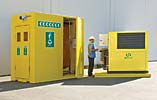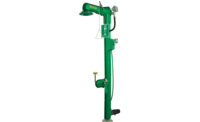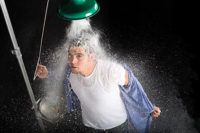
How hot is too hot?
As traditional manufacturing moves off-shore, it’s interesting that the geographic areas of focus seem to be mostly within warmer, if not downright hot, climates. Geographically warm areas are struggling to keep pace with a mushrooming demand for lower cost parts, components and finished products. At the same time, new manufacturing processes and advanced technologies often generate significantly more process heat as they operate. And, if that’s not enough, the growth in global dependence on Mid-Eastern petroleum resources continues to stress that region’s facilities, which are obviously in very warm climates.
Much the same circumstances have been present here in the U.S., in areas such as the desert Southwest. The entire situation, domestic and foreign, places an ever-increasing population of workers in a dangerous position: Emergency response assets, including drench showers and eyewashes, must not only be made available, but these facilities require cooling of the water that flows through them to avoid inflicting potentially worse injuries on users. If an injured worker jumps under the shower or forces his face into an eyewash stream heated by the environment it is exposed to, some dire results could easily follow. Second- and even third-degree burns are easily possible. In fact, water at 100°F is already sufficiently hot to damage the delicate tissue of the eyes and other areas of the body.
Taking chances
For many years, the operating water temperature range of industrial emergency drench showers and eyewashes was left open to fluctuations, based on ambient temperatures and other exposures. The water that flowed through emergency equipment was subject to climatic, source affected and other variables that could raise it to dangerously high temperatures or lower it to hypothermia-inducing cold temperatures with no regulations or range limitations. You pulled the handle, pushed the flag or rotated the foot treadle on your emergency shower or eyewash and you got what you got. All of that changed with the 2004 revision of ANSI Z358.1.
Currently, OSHA 29CFR 1910.151 requires the availability of suitable first-aid treatment facilities. Direction is given indicating that “suitable facilities for quick drenching or flushing of the eyes and body shall be provided…”
In the past, the definition of “suitable” was generally left to the specifier’s discretion. However, ANSI Z358.1-2004 provides clarification. And, that clarification virtually eliminates all ambiguity. Sustained outlet temperatures, per the standard, must be no lower than 60°F and below 100°F during a full 15-minute use cycle for either an emergency shower or eyewash. Water that is colder could lead to hypothermia, while hotter temperatures can damage sensitive areas of the body. Additionally, higher temperature water when applied to chemical splashes can actually intensify the injury.
In either case, the discomfort of the victim can also lead to premature cessation of the emergency equipment use. The idea of an injured worker short-cutting the required emergency equipment use cycle because the water is too cold or hot obviously led to the establishment of the outlet water temperature range specified by ANSI.
Cooling feed water
Recently, we have seen a dramatic increase in requests for cooling emergency equipment feed water. In these instances, radiant and ambient temperatures in many areas within a warm climate plant often drive standing water temperatures up above 120°F. The dynamics of heat transfer will raise the standing water temperature at the emergency equipment to dangerous levels approaching the maximum ambient/radiant air temperature. When actuated, the emergency equipment would deliver very hot water to the injury victim, exacerbating the injury, creating more physical harm or causing the victim to recoil from the flow and cease the drench or irrigation protocol.
The most popular approach to cooling high ambient temperature water to bring it within the guidelines is to size a chiller and recirculation loop to maintain the proper temperature at all times for all equipment on the loop. A variety of different products are available, based on the volume of water required at peak demand and the footprint of the recirculation loop specified.
The accompanying photo (above) shows a large capacity separate chiller plumbed directly to an outdoor enclosed emergency environment drench shower booth. This configuration can also be used to allow the chiller to serve the needs of several showers on a closed recirculation loop. As is also the case with warming technologies, all components must be matched to assure the availability of proper peak flow rates and temperatures. Emergency equipment manufacturers are in the best position to assist with system design, as they know their equipment flow rates, peak demands and other associated requirements.
Designing and managing an emergency equipment system that is capable of delivering sustained use volumes of properly tempered water should be a step-by-step process. It’s a matter of identifying your risks, sizing your total system for peak flow use and factoring in local water conditions (pressure and temperature), as well as seasonal and process-related variations. Only then is it possible to specify and match your overall need to a tailored system, capable of delivering emergency equipment water temperatures that are within the required range.
Even in international areas that are not bound by ANSI requirements, the common-sense approach used in establishing the Z358.1-2004 requirement should be used as a guide for properly preparing for the first-aid needs of workers in any and all environments.

